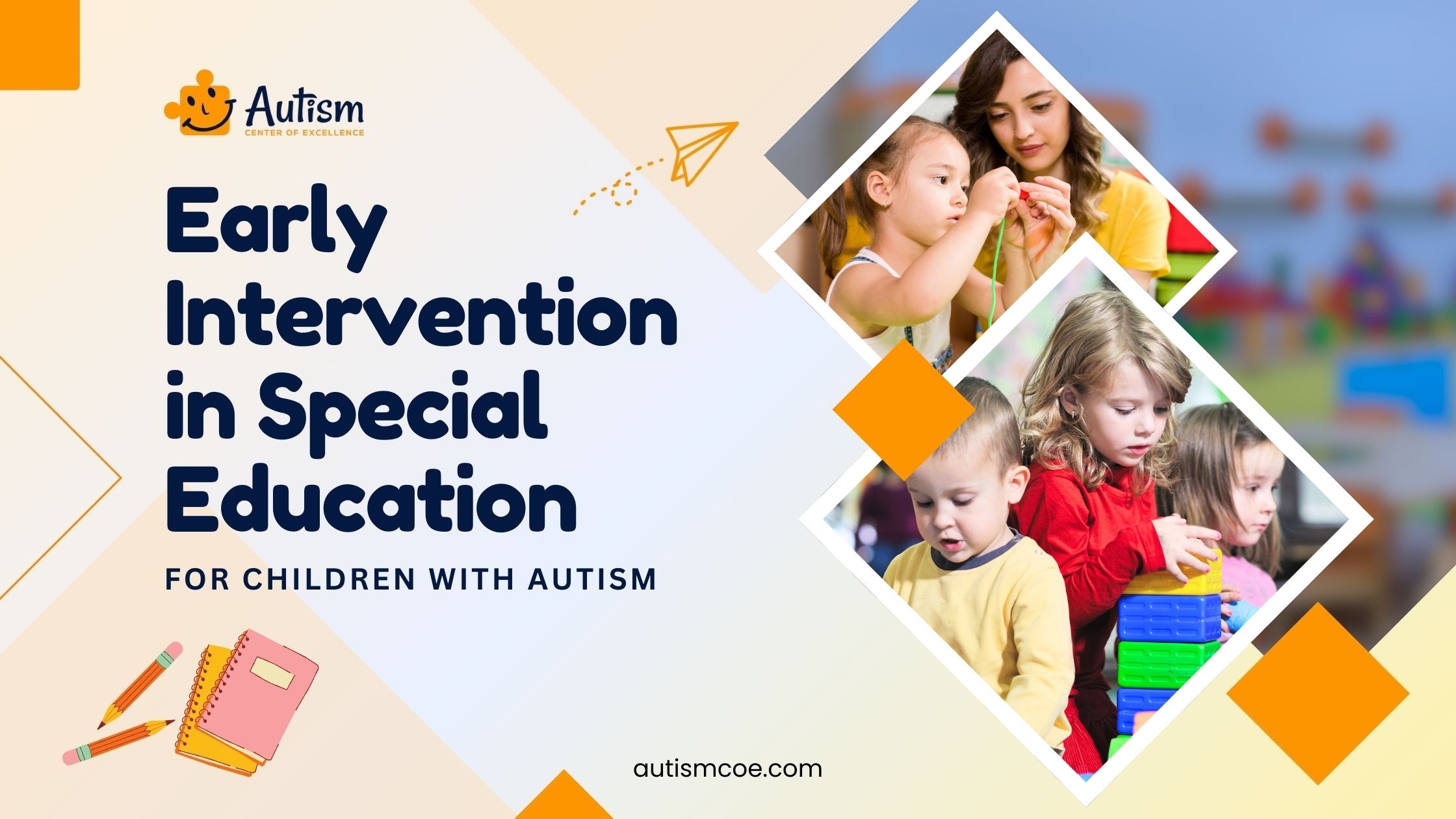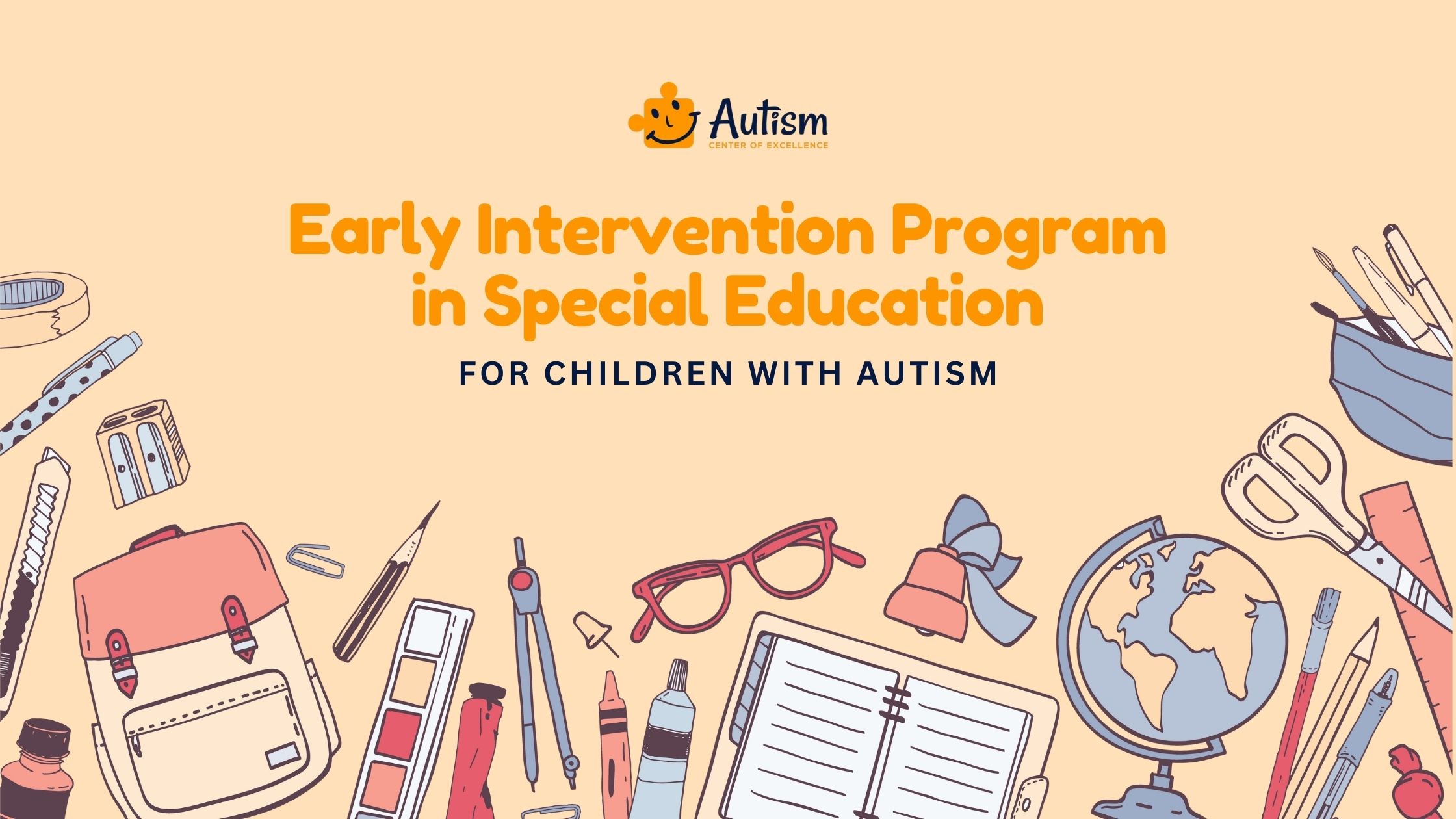Early Intervention in Special Education for Children with Autism Spectrum Disorder

Autism can be a challenging condition to manage in children, but there is hope when the child is provided with an early intervention. Knowledge of Autism Early Intervention in special education and the various strategies used can be helpful to parents in ensuring they get the best results for their children.
Early intervention in special education is crucial because it provides children with the necessary support and resources to reach their full potential. Studies conducted have demonstrated that early childhood intervention could positively influence the success level of children with ASD. In this article, we are going to highlight the benefits of early intervention in special education for children with autism and discuss some general applied methods of early childhood special education.
Traditional Education vs. Autism: Children’s Challenges
Children with autism face unique challenges that often make traditional educational settings difficult for them. These kids can have difficulties in communication, exhibit various problems in interacting with other children or adults, and struggle with regulating their actions.
For instance, a Child with Autism may not understand other children’s signals, may have difficulties using words in order, or may display repeated movements that interfere with learning. These challenges can greatly affect the child’s academic performance as he/she goes through school.
That is the reason why intervention at the first signs of a learning disability is crucial. If the signs are detected at an early age, then the required assistance may be given to help them cope with these challenges. Intervention in children with these difficulties helps in their development and well-being, hence paving the way for success.

Early Intervention Program in Special Education for Children with Autism
Early intervention is a set of services and support provided to infants and toddlers with developmental concerns or disabilities, including autism, before the age of three. These services, crucial during the developmental years, can significantly influence a child’s growth trajectory.
Intervention strategies in special education are primarily focused on improving the child’s communication, social, and Cognitive Development. These early interventions aim to address developmental delays and equip children with the necessary skills to thrive as they grow older. The earlier these services are implemented, the more effective they tend to be in fostering positive outcomes.
Examples of early intervention services in special education include:
☑️ Applied Behavior Analysis (ABA)
☑️ Physical Therapy
☑️ Social Skills Groups
☑️ Developmental /Educational Intervention
Such therapies are not just about addressing immediate developmental concerns but also about enhancing major life skills and preparing children to encounter and adapt to other educational environments as they grow. Early intervention can lay a strong foundation for future learning and personal development, ensuring that children with autism have the best possible start in life and continue to thrive as they develop.
Enjoying Reading?
Join Our Weekly Newsletters!
Subscribe now to stay updated with our latest email updates.
Individualized Education Program (IEP)
One of the effective models that may help to deal with the problem of children with autism is the Individualized Education Program (IEP). The IEP outlines specific instructional goals, support, and modifications tailored to the child’s needs. The IEP is a collaborative effort involving parents, teachers, therapists, and other professionals, all working together to help the child reach their full potential and provide targeted assistance in areas needing improvement.
The goals set in an IEP are SMART—Specific, Measurable, Achievable, Relevant, and Time-Bound—covering academic, social, and behavioral development. These goals are revised periodically to monitor the performance and changes. The intervention is then adjusted to ensure that the child gets specialized care for their needs.
Suggested – ABA for School Readiness: Parent’s Guide to IEP
Essential Strategies in Special Education for Autism Intervention
Interventions for children with autism are most effective when done with the help of many professionals. This is effective as teachers, therapists, medical personnel, and parents work together to come up with an integrated plan for the child.
Individualized Approach
Another important principle of early intervention is individualized intervention. Every child with autism is different from the others, so their IEPs should include their talents, areas of difficulty, and preferences. This makes interventions specific to the individual, which makes them appropriate and efficient.
Parent Involvement
Parents are vital in the success of early intervention services. Active Parent Participation in The Intervention Process ensures that the child practices the learned skills in both a school and home environment. This also gives parents a way to know and do what is right for their child.
Use of Evidence-Based Practices
Evidence-based practices are critical in early intervention strategies. These practices have empirical support and are quite useful in enhancing positive results for children with autism. These include Applied Behavior Analysis (ABA), Picture Exchange Communication System (PECS) and social skills training.

Why Early Childhood Special Education is Important?
Early childhood special education follows early intervention services and applies to children three to five years old. This transition period is important since it prepares the children for the more rigid system of kindergarten and elementary schools.
Specialized Preschool Programs
It is for this reason that many Children with Autism Attend Specialized Preschools that are designed to fit their educational needs. These programs normally entail a schedule, one-on-one teaching, and other interventions. The aim is to improve social, communication and adaptive behavior within a structured and welcoming setting.
Inclusive Education
Inclusive Education is also another key concept used in early childhood special education. It entails placing Children with Autism in The General Classroom with the necessary assistance and modifications. This way, it creates an environment for socialization, as well as the students’ acceptance and the feeling of being part of a group.
Creating a Strong Foundation
Early childhood is a critical period for learning and development. It helps create a strong foundation for children with autism to reach their full potential by providing them with the necessary skills and strategies to succeed in various areas, giving them the right support and tools early on can make a significant difference in their future academic and personal achievements.
Long-Term Impact of Early Intervention in Special Education
The advantages of early identification and intervention in special education are not limited to the preschool years only. Studies have also indicated that children who are provided with early intervention services are likely to have enhanced results in several aspects of their lives.
Improved Developmental Outcomes
Pertinent to this discussion, it is important to note that the earlier the intervention, the better the chances of improving a child’s developmental path. When the child is provided with early and adequate treatment, there is usually a positive change in the child’s communication, social and cognitive development. These achievements can be the building blocks for future academic and interpersonal achievements.
Increased Independence
Early intervention for children with autism is crucial as it helps them acquire essential life skills, fostering independence. Specific interventions enhance problem-solving and decision-making abilities, among other competencies. This increased autonomy can significantly improve their quality of life as they grow older.
Enhanced Family Well-Being
Not only does early intervention help the child, but it also improves the well-being of the family. Parents who are engaged in the intervention process increase their confidence and feel that they have the power to influence their child’s development. It also helps with stress and anxiety, thus, making family relations better and improving the spirit of the family.
Frequently Asked Questions & Answer
What is the Main Goal of Early Intervention?
The overall purpose of early intervention treatments is to offer specific activities and help to child within the first years of his or her life to enhance development and reduce the consequences of developmental problems and/or disabilities.
What is Intervention in Special Education?
To address the needs of children with disabilities, special education intervention employs techniques including speech therapy, occupational therapy, and educational programs that are specifically designed to foster social, communicative, and adaptive skills.
What is the Difference Between Early Intervention and Early Childhood Special Education?
Early intervention (birth to three years old) provides family-centered interventions to address delays and disabilities at an early age. Children in early childhood special education (ages three to five) get customized preschool programs, IEPs, and inclusive classrooms to help them be ready for school.
How Do I Get Started with Early Intervention Services for My Child with Autism?
First, you should turn to your pediatrician and explain your concerns; they can direct you to early intervention programs or specialists to be assessed and receive further services.
Conclusion
Special education for autism is a field that can change the lives of children and their families if done early. Thus, knowing what early intervention is, the strategies used, and the outcomes that can be expected, parents can help their child in the right way.
IEP is one of the programs that help in designing and implementing proper programs and interventions for the child. Autism is a condition that can be managed and children with the condition can do very well with the right kind of help.
If you are in need of assistance and advice for Early Intervention Services for your child, then please do not hesitate to contact AutismCOE. We provide one-on-one counseling services, information and support for the entire journey. Altogether we can pave the way to a better future for your child and help them become the best they can be.
Please Note: The content of this blog is for informational purposes only and should not be considered a substitute for professional medical advice, diagnosis, or treatment. Consult a qualified healthcare professional for personalized guidance tailored to your specific situation.

Bhavika Bhasin
Bhavika Bhasin is the Research and Marketing officer at AutismCOE. She works with children and adults with ASD. Her clinical research includes evaluating various available autism screening and diagnosis methods and their efficacy. She is currently developing a novel screening exam that is indicated to be more accurate than the existing available exams. She is also writes articles papers for various publications.

